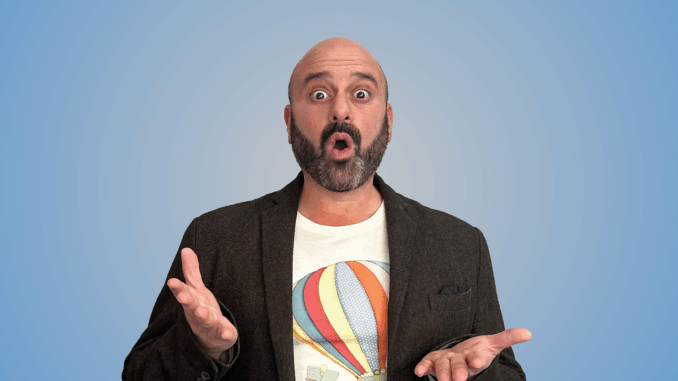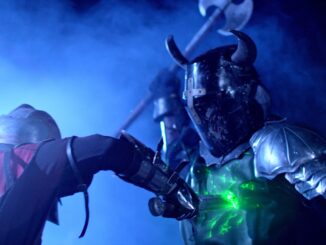
As Covid spread in the spring of 2020: theaters went dark, curtains closed, tours halted, rehearsals suspended indefinitely. For playwright Lynn Rosen, like so many others in New York’s tight-knit theater world, the pandemic had not only stopped performances—it had taken away the very process of making theater. It wasn’t just the work that disappeared—it was the community, the energy of a live audience and the sense of purpose that came with it. However, in that unexpected quiet, Lynn Rosen found that a new form of creativity could emerge.
Lynn and Chad Kessler talked about the origin of Gasbag. “I, as a writer, write about things that intrigue me or are mysterious to me or that I don’t understand,” Lynn explained. “Often my stories are based on real people or real situations. I’ve always been fascinated by people who talk too much—who can’t allow a pause in a conversation.” Chad Kessler: “Yeah, I can be like that.”
Lynn: “It’s like, what thoughts are they trying to block out by constantly talking? George Nordstrom, the main character, is like that. He has this wonderful energy, a bubbly personality, and is beautifully chatty. Chad and I hit it off right away. He’s funny, a great actor, and I thought, He could absolutely play this over-talker in the most endearing way possible,” Lynn said. “I didn’t work on the idea right away—I had other projects—but then COVID hit. We were all trapped in our apartments, and I just thought, “I have to keep creating, stay connected to my friends, and maybe make people laugh. That’s my job as a writer: to bring some delight. So I sent it to Chad and said, “Hey”, I wrote this monologue for the over-talker. Let’s shoot it on Zoom or something.”

However Chad was still recovering from Covid and not in great shape to start production. “I had COVID, right? I was like patient zero. It was March 18, 2020, and I was pretending I didn’t have it because it was a scary time,” he recalls. “Lynn wrote the monologue, but I had brain fog and couldn’t memorize it. Eventually, I got over COVID and worked through it.” At first it was just one little thing we thought we’d post online. But then I showed it to my friend Tina Chilip, an actress I admire. We’d become friends, and she knew Lynn’s work—Lynn who was a recipient of The Visionary Playwright Award is also a TV writer. Tina was like, “Lynn wrote this for you? That’s amazing.” She read it and said she wanted to do something with it. So Lynn created this cast of characters around George, and we took off. Because of Lynn’s stature in the theater world, we were able to pull in amazing New York actors. I’m beyond grateful and lucky that she chose me to play George.”
They shared the piece with their friend, director Meredith McDonough, who joined them to help bring it to life. In the middle of isolation and uncertainty, they found their way back to storytelling—one tiny screen at a time. With most of the theater community out of work and hungry for creative outlets, Rosen and Kessler surrounded themselves with actors from the theater world, many of whom had never been seen on screen in this way. Drama Desk-winner Mary Bacon plays George’s acidic coworker Sherri, a character as funny as she is fearsome. Jackie Tohn (Nobody Wants This, Glow) and Deidre Lovejoy (The Blacklist,The Wire) round out the cast.

Lynn: People really responded to it—more than we expected. But then the writers’ and actors’ strikes happened, and again, a lot of performers were just sitting around, eager to apply their craft. So I said, “Let’s do season two. Not on Zoom—we’ll use iPhones, boom mics, Filmic Pro… the whole nine yards.” So they shot the second season on an iPhone 14 Pro Max using Filmic Pro, a $5.99 app.

As funny as George the over-talker is, this is not just vaudeville. Beneath the chatter is someone striving to be seen beyond his diagnosis—to lead, to love, to be whole. In rare, quiet moments, when the talking subsides, we glimpse the hope of a life no longer defined by limitation but by possibility. Demonstrating to us all that diagnosis for us is not a definition but a description and is never a determination. Chad went on to explain, “And we got even more amazing actors. A lot of them had seen the first season and liked it. We’re just all friends and family. We’ve gotten even closer making it, and I think you can feel the joy in the show.”
The unique blend of theater and video gives Gasbag a special sparkle—something I might never have experienced without the creative freedom of the Dances With Films Festival. Gasbag Season 2 stands out as a joyful, unfiltered burst of talent and camaraderie. It’s a perfect antidote to troubling times, and a powerful reminder of what can be created without barriers, big budgets, or waiting for permission from the establishment.


Be the first to comment